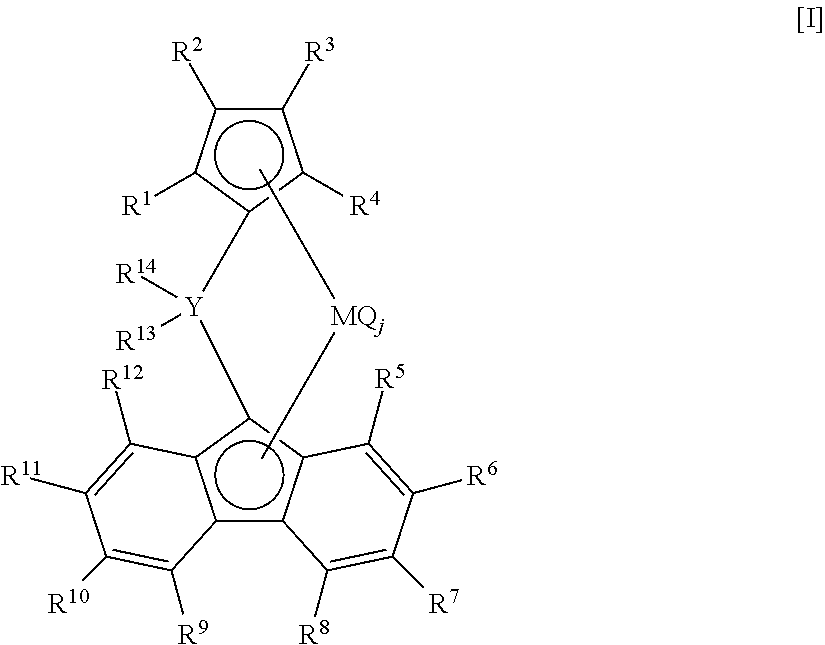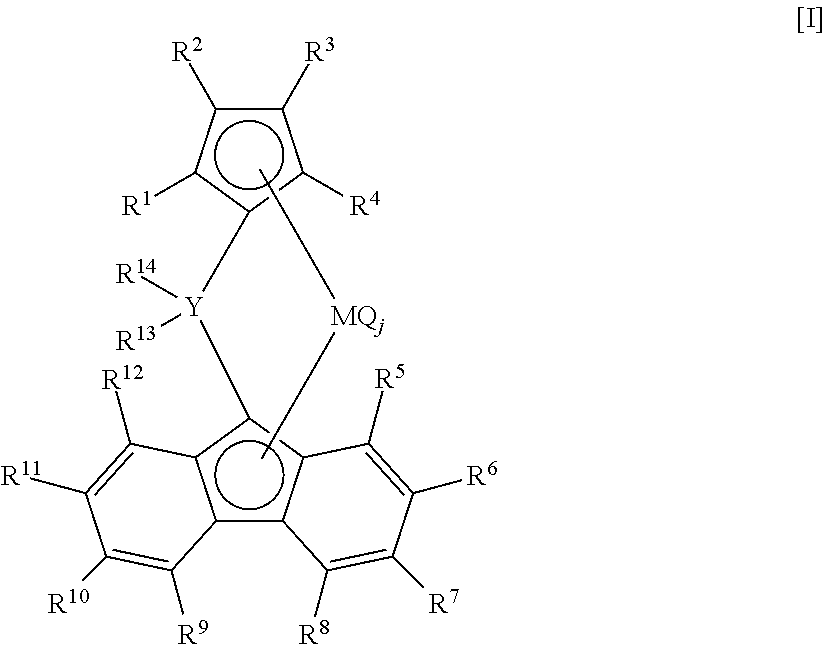Process for producing ethylene/alpha-olefin copolymer
- Summary
- Abstract
- Description
- Claims
- Application Information
AI Technical Summary
Benefits of technology
Problems solved by technology
Method used
Image
Examples
synthesis example 1
Synthesis of [bis(4-N-morpholinylphenyl)methylene(η5-cyclopentadienyl)(η5-octamethyloctahydrodibenzofluorenyl)]hafnium dichloride
(i) Synthesis of bis(4-N-morpholinylphenyl) (cyclopentadienyl)(octamethyloctahydrodibenzofluorenyl)methane
[0284]In nitrogen atmosphere, to a 100 ml three-neck flask, 1.24 g (3.21 mmol) of octamethyloctahydrodibenzofluorene, and 80 ml of dehydrated THF were introduced. Thereto, in an ice water bath, 1.97 ml (3.26 mmol) of a 1.66 M n-butyllithium hexane solution was slowly added dropwise. While gradually returning to room temperature, the mixture was stirred for 20 hours. Thereto, in an ice water bath, 1.08 g (2.69 mmol) of 6,6-bis(4-N-morpholinylphenyl)fulvene was added. The mixture was stirred for 4 hours at room temperature. Thereafter, to the reaction solution, saturated ammonium chloride water was added to separate the organic layer. The aqueous layer was subjected to extraction with diethyl ether. The resultant organic layers were combined, washed one ...
synthesis example 2
Synthesis of [bis[4-(dimethylamino)phenyl]methylene(η5-cyclopentadienyl)(η5-octamethyloctahydrodibenzofluorenyl)]hafnium dichloride
(i) Synthesis of 6,6-bis[4-(dimethylamino)phenyl]fulvene
[0288]In nitrogen atmosphere, to a 200 ml three-neck flask, 3.06 g (42.4 mmol) of lithiumcyclopentadienide, 10.1 g (37.5 mmol) of 4,4′-bis(dimethylamino)benzophenone, and 100 ml of dehydrated DME were added. While the mixture was cooled in an ice bath, 4.86 g (42.6 mmol) of DMI was added. Thereafter, the mixture was stirred under heating to reflux for 8 days. While the mixture was cooled in an ice bath, 50 ml of water was gradually added. 50 ml of dichloromethane was further added, and the mixture was stirred for 30 minutes at room temperature. The resultant two-layer solution was transferred to a 300 ml separating funnel. The organic layer was washed three times with 100 ml of water, and dried over anhydrous magnesium sulfate for 30 minutes. Subsequently, the solvent was distilled off under reduced...
synthesis example 3
Synthesis of [bis(3-N-morpholinylphenyl)methylene(η5-cyclopentadienyl)(η5-octamethyloctahydrodibenzofluorenyl)]hafnium dichloride
(i) Synthesis of bis(3-N-morpholinylphenyl)(cyclopentadienyl)(octamethyloctahydrodibenzofluorenyl)methane
[0294]In nitrogen atmosphere, to a 100 ml three-neck flask, 2.0 g (5.17 mmol) of octamethyloctahydrodibenzofluorene, and 80 ml of dehydrated THF were introduced. Thereto, in an ice water bath, 3.5 ml (5.43 mmol) of a 1.56 M n-butyllithium hexane solution was slowly added dropwise. While gradually returning to room temperature, the mixture was stirred for 4 hours. Thereto, in an ice water bath, 2.17 g (5.4 mmol) of 6,6-bis(3-N-morpholinylphenyl)fulvene was added. The mixture was stirred for 5 hours at room temperature. Thereafter, to the reaction solution, a saturated ammonium chloride water was added to separate the organic layer, and the aqueous layer was subjected to extraction with diethyl ether. The resultant organic layers were combined, washed one...
PUM
| Property | Measurement | Unit |
|---|---|---|
| Temperature | aaaaa | aaaaa |
| Percent by mole | aaaaa | aaaaa |
| Percent by mole | aaaaa | aaaaa |
Abstract
Description
Claims
Application Information
 Login to View More
Login to View More - R&D
- Intellectual Property
- Life Sciences
- Materials
- Tech Scout
- Unparalleled Data Quality
- Higher Quality Content
- 60% Fewer Hallucinations
Browse by: Latest US Patents, China's latest patents, Technical Efficacy Thesaurus, Application Domain, Technology Topic, Popular Technical Reports.
© 2025 PatSnap. All rights reserved.Legal|Privacy policy|Modern Slavery Act Transparency Statement|Sitemap|About US| Contact US: help@patsnap.com



